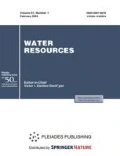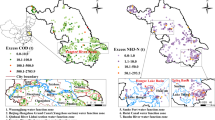Abstract
The industrial sewage pollution has become a public attention issues with the development of economy. The path analysis is employed to investigate the countermeasures of reducing Chemical Oxygen Demand (COD) and ammonia nitrogen (NH3–N) discharge. The result shows that urbanization rate (UR), industrial gross domestic product (IGDP), and environmental investment (EI) co-determine the COD discharge, while UR, IGDP, EI and per capita gross domestic product co-determine the NH3−N discharge. UR is the main factor for restraining COD and NH3-N discharge, with the total effect of 42.59 and 33.37% respectively. IGDP has a positive direct effect on pollutants discharge.



Similar content being viewed by others
REFERENCES
Anton, D., Kohout, J., and Pain, N., Nationalizing environmental protection in Australia: The international dimensions, Nucleic Acids Res., 2008, vol. 21, pp. 5815–5820.
Chen, J. and Wang, J., Empirical analysis on China’s environmental investment and economic growth, Studies in Sociol. Sci., 2016, vol. 2, pp. 6–12.
Fujikura, R., Environmental policy in Japan: Progress and challenges after the era of industrial pollution, Environ. Policy Governance, 2011, vol. 21, pp. 303–308.
Huang, X., Zhang, J., Luo, L., Tang, Q., Luo, B., Zhang, W., Deng, S.-H., Shen, F., Yao, X.-P., and Xiao, H., The influence of GDP, population, and net export value on energy consumption, Energy Sources, Part B, 2017, vol. 9, pp. 1–7.
Li, C., Feng, W., Song, F., He, Z., Wu, F., Zhu, Y., Pgiesy, J., and Bai, Y., Three decades of changes in water environment of a large freshwater lake and its relationship with socio-economic indicators, J. Environ. Sci-China, 2019, vol. 77, pp. 156–166.
Li, L., Lei, Y., and Pan, D., Economic and environmental evaluation of coal production in China and policy implications, Natural Hazards, 2015, vol. 77, pp. 1125–1141.
Liang, D., Fujita, T., Ming, D., Yong, G., Ren, J., Fujii, M., Yi, W., and Ohnishi, S., Towards preventative eco-industrial development: an industrial and urban symbiosis case in one typical industrial city in China, J. Cleaner Prod., 2016, vol. 114, pp. 387–400.
Lin, Q., Chen, G., Du, W., and Niu, H., Spillover effect of environmental investment: evidence from panel data at provincial level in China, Front. Environ. Sci. Eng., 2012, vol. 6, pp. 412–420.
Liu, X., Zhang, M., Zhang, J., Yang, Z., Gou, Q., and Deng, S., Application of an Interpolation Method in Pollution Survey by Matlab, IOP Conf. Ser.: Earth and Environmental Science, 2018, vol. 03, pp. 51–56.
Song, G., Min, H., Zamora, M.L., Jianfei, P., Dongjie, S., Jing, Z., Zhuofei, D., Zhijun, W., Min, S., and Limin, Z., Elucidating severe urban haze formation in China, Proc. Natl. Acad. Sci. U. S. A., 2014, vol. 111, pp. 17373–17378.
Tong, Z., Yue, H., Jing, Z., and Hao, W., Technological innovation paths toward green industry in China, China Population, Resources and Environ., 2018, vol. 16, pp. 97–108.
Wang, Q. and Yang, Z., Industrial water pollution, water environment treatment, and health risks in China, Environ. Pollut., 2016, vol. 218, pp. 358–365.
Wang X.L. and Wang G.H., China’s urban employment and urbanization rate: A re-estimation, China & World Economy, 2014, vol. 22, pp. 30–44.
Yang, D., Kao, W.T.M., Ning, H., Wang, R., Xin, Z., and Wei, Z., Process-based environmental communication and conflict mitigation during sudden pollution accidents, J. Cleaner Prod., 2014, vol. 66, pp. 1–9.
Yue, Z., Gu, A., and Pan, B., Relationship between industrial water consumption and economic growth in China based on environmental Kuznets Curve, Energy Procedia, 2017, vol. 105, pp. 3557–3564.
Zhang, J., Application the optimization models to analysis the industrial pollution emission in China, Environ. Prot. Eng., 2013, vol. 39, pp. 87–99.
Zhang, J., Zhang, L.-Y., Du, M., Zhang, W., Huang, X., Zhang, Y.-Q., Yang, Y.-y., Jianmin, Z., Deng, S.-H., Shen, F., Li, Y.-W., and Xiao, H., Identifying the major air pollutants base on factor and cluster analysis, a case study in 74 Chinese cities, Atmos. Environ., 2016, vol. 144, pp. 37–46.
Zhang, J., Zhang, L.-Y., Zhang, J.M., Shi-huai, D., Zhang, Y.Z., Li, Y.W., Shen, F., Yang, G., and Song, C., Theoretical relationship between energy consumption and economic output, Energy Sources, Pt B, 2016, vol. 11, pp. 643–650.
Zhang, L.-Y., Li, Y., Zhang, J., Luo, B., He, J.-M., Deng, S.-H., Huang, X., Luo, L., Shen, F., Xiao, H., Zhang, Y.-Z., Li, Y.-W., Wang, L.-L., Yao, X.-P., and Zhang, Y.-Q., The relationships among energy consumption, economic output and energy intensity of countries at different stage of development, Renewable Sustainable Energy Rev., 2017, vol. 74, pp. 258–264.
Zhou, W.Y., Yang, W.L., Wan, W.X., Zhang, J., Zhou, W., Yang, H.S., Yang, H., Xiao, H., Deng, S.H., and Shen, F., The influences of industrial gross domestic product, urbanization rate, environmental investment, and coal consumption on industrial air pollutant emission in China, Environ. Ecol. Stat., 2018, vol. 25, pp. 429–442.
Zhou, Y., Ma, J., Zhang, Y., Qin, B., Jeppesen, E., Shi, K., Brookes, J.D., Spencer, R.G.M., Zhu, G., and Gao, G., Improving water quality in China: Environmental investment pays dividends, Water Res., 2017, vol. 118, pp. 152–159.
ACKNOWLEDGMENTS
This study was supported by Key Projects of Scientific Research of the Education Department of Sichuan Province (no. 17ZA0303). Key Projects of Science and Technology Department of Sichuan Province (2017SZ0173).
Author information
Authors and Affiliations
Corresponding authors
Rights and permissions
About this article
Cite this article
Xin-Cong Liu, Zhang, MD., Zhou, WY. et al. A Path Analysis for Chemical Oxygen Demand and Ammonia Nitrogen Discharge from Industrial Sewage in China. Water Resour 47, 1012–1019 (2020). https://doi.org/10.1134/S0097807820060172
Received:
Revised:
Accepted:
Published:
Issue Date:
DOI: https://doi.org/10.1134/S0097807820060172




